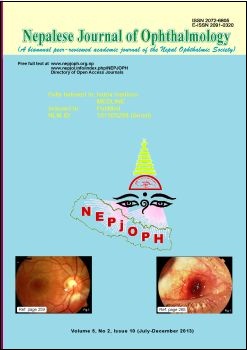Prevalence and determinants of xerophthalmia in rural children of Uttarpradesh, India
DOI:
https://doi.org/10.3126/nepjoph.v5i2.8733Keywords:
prevalence, rural children, xerophthalmiaAbstract
Introduction: Vitamin A deficiency (VAD) is recognized as a major cause of blindness among children in India.
Objective: To find out the prevalence of VAD in rural children of Uttar Pradesh, India.
Materials and methods: This cross-sectional study was undertaken amongst children (0-15 years) in a rural area of Bareilly (Uttar Pradesh) where the study population was selected by simple random sampling out of villages under a Primary Health Centre. Out of 844 children, 802 participated in the study. The WHO classification of xerophthalmia was used.
Results: Overall, the prevalence of xerophthalmia was 5.4 %. The prevalence of Bitot’s spots was 0.9 % in children under six years of age and 3.3 % in children above six years. The prevalence of xerophthalmia was significantly more in older children. Overall, the prevalence of anemia was found to be 11.8 % in the study population. A significantly high prevalence of xerophthalmia (OR= 5.7; 95 % CI = 2.8 - 11.5) was observed in children suffering from anemia.
Conclusion: The presence of a milder manifestation of xerophthalmia and a 0.9 % prevalence of Bitot’s spot in children under six years of age in the present study shows a declining trend of VAD although it is still a public health problem. The higher prevalence in children above six years of age shows that apart from strengthening of Vitamin A prophylaxis programs, health education is needed for dietary diversification to include vegetables and fruits in the diet for long-term sustainability in improving the vitamin A status of children of all age groups.
Nepal J Ophthalmol 2013; 5(10): 226-229
Downloads
Downloads
Published
How to Cite
Issue
Section
License
This license enables reusers to copy and distribute the material in any medium or format in unadapted form only, for noncommercial purposes only, and only so long as attribution is given to the creator.




